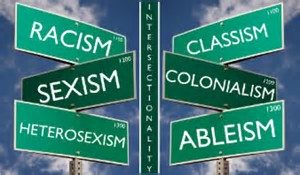The Pittsburgh Sister March like The Women’s March on Washington has drawn some criticism over inclusivity. The march on Washington had time to grow and eventually broadened and developed a more intersectional platform.
Intersectionality is important so each of us can understand where we stand in the struggle for freedom, as well as where we stand to help others, who may not have the privileges we have as white women.
It’s crucial to understand women’s rights through an intersectional lens to lift up communities that have been historically marginalized.
The term intersectionality dates back to 1989 when it was coined by Kimberlé Crenshaw, a law professor at UCLA and Columbia. intersectionality is defined as follows:
Intersectionality is a way of looking at the overlap and intersections of people’s social group identities (e.g. race, gender, class, gender identity, religion, sexual orientation, disability, etc.) and addresses the related and intersecting systems of bias, discrimination, and oppression.
and oppression.
A useful example of intersectionality is the gender wage gap. If we examine the gender wage gap as a whole, we know that women are paid 80% of what men earn. However, if we dig deeper and ask the right intersectionality questions, we can see that for women of color, that disparity is even greater, 54% for Latina and 63% for African-American women, who earn less than their white (75%) and Asian (85%) counterparts. This information is critical in gaining a full understanding of the gender wage gap, reflecting on how bias and discrimination manifest differently, addressing needs and confronting the inequities. If change continues at the slower rate seen since 2001, women will not reach pay equity with men until 2152.
In the Women’s March’s Guiding Vision and Definition of Principles, intersectionality is addressed explicitly by stating, “Recognizing that women have intersecting identities and are therefore impacted by a multitude of social justice and human rights issues, we have outlined a representative vision for a government that is based on the principles of liberty and justice for all.”
Talking about the Women’s March is an effective way to spark conversations about intersectionality. Here are some other ways to consider teaching or talking with young people about it:
For younger elementary age children, introduce them to the fact that we all have more than one identity and that the combination of those identities makes us unique and each identity has a different level of importance at different points in our lives.
As children get older, continue to help them reflect on their own identities as well as others. In addition, they can begin to examine the intersections of different aspects of identity and be able to understand the perspective of others’ identities. s.
Have young people reflect upon the Women’s March as well as other examples of social activism throughout the years, using an intersectionality approach. For example, when studying the Civil Rights Movement, help them overlay the lens of gender and race and sexual identity to explore how those voices differed and the extent to which they were included or excluded from the movement.
Leave a Reply